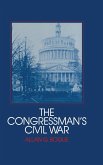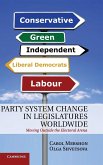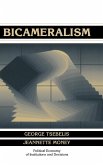The 104th Congress, the first in four decades to be Republican-controlled, may prove to have ushered in an era of party dominance by congressional Republicans, or to be a transitory aberration. Either way, the 104th is a watershed in congressional history. Using the theater metaphor to characterize the actions of Congress and to help make the institution more understandable, Congressional life and behavior is dissected and placed in the broader context of changes in Congress in the 1990s. The contributors evaluate the way members of Congress play to the media and the larger audience, the electorate; analyze leadership roles in a cast of 535 'leading players'; evaluate the committee systems as 'little theatre'; and analyze relations among the various branches of government. Herbert Weisberg and Samuel Patterson conclude the unique presentation by reminding us that in Congress, 'the play's the thing.'
Table of contents:
Part I. Introduction: 1. Theater in the round: congress in action Herbert F. Weisberg and Samuel C. Patterson; Part II. Congress and its Audience; 2. Representation in congress: line drawing and minorities Kenny J. Whitby and Franklin D. Gilliam Jr; 3. Unsympathetic audience: citizens' evaluation of congress Samuel C. Patterson and David C. Kimball; 4. Back from intermission: the 1994 elections and the return to divided government Dean Lacy; Part III. Congress at Play: 5. Directing 535 leading men and leading ladies: party leadership in the modern congress Paul S. Herrnson; 6. Little theater: committees in congress Tim Groseclose and David C. King; 7. The unfolding drama: party ideology in the 104th house Barry C. Burden and Aage R. Clausen; Part IV. Congress and Other Actors: 8. The plot thickens: congress and the president Barbara Sinclair; 9. Congress and the courts: a case of casting Elliot E. Slotnick and Sheldon Goldman; 10. Behind the scenes: the Supreme Court and congress in statutory interpretation Lori Hausegger and Lawrence Baum; 11. Congress and foreign policy: a neglected stage Randall B. Ripley; Part V. Conclusion: 12. The play's the thing: congress and the future Samuel C. Patterson and Herbert F. Weisberg.
The 104th Congress, the first in four decades to be Republican-controlled, is a watershed in congressional history. Using the theater metaphor to characterize the actions of Congress and to help make the institution more understandable, Congressional life and behavior is dissected and placed in the broader context of changes in Congress in the 1990s. This book underscores the relationship between Congress and the other branches of the United States government.
Using the theater metaphor to characterize the actions of Congress and to help make the institution more understandable, Congressional life and behavior is dissected and placed in the broader context of changes in Congress in the 1990s.
Table of contents:
Part I. Introduction: 1. Theater in the round: congress in action Herbert F. Weisberg and Samuel C. Patterson; Part II. Congress and its Audience; 2. Representation in congress: line drawing and minorities Kenny J. Whitby and Franklin D. Gilliam Jr; 3. Unsympathetic audience: citizens' evaluation of congress Samuel C. Patterson and David C. Kimball; 4. Back from intermission: the 1994 elections and the return to divided government Dean Lacy; Part III. Congress at Play: 5. Directing 535 leading men and leading ladies: party leadership in the modern congress Paul S. Herrnson; 6. Little theater: committees in congress Tim Groseclose and David C. King; 7. The unfolding drama: party ideology in the 104th house Barry C. Burden and Aage R. Clausen; Part IV. Congress and Other Actors: 8. The plot thickens: congress and the president Barbara Sinclair; 9. Congress and the courts: a case of casting Elliot E. Slotnick and Sheldon Goldman; 10. Behind the scenes: the Supreme Court and congress in statutory interpretation Lori Hausegger and Lawrence Baum; 11. Congress and foreign policy: a neglected stage Randall B. Ripley; Part V. Conclusion: 12. The play's the thing: congress and the future Samuel C. Patterson and Herbert F. Weisberg.
The 104th Congress, the first in four decades to be Republican-controlled, is a watershed in congressional history. Using the theater metaphor to characterize the actions of Congress and to help make the institution more understandable, Congressional life and behavior is dissected and placed in the broader context of changes in Congress in the 1990s. This book underscores the relationship between Congress and the other branches of the United States government.
Using the theater metaphor to characterize the actions of Congress and to help make the institution more understandable, Congressional life and behavior is dissected and placed in the broader context of changes in Congress in the 1990s.








